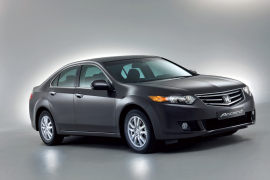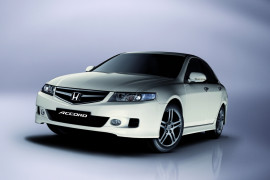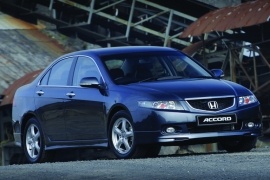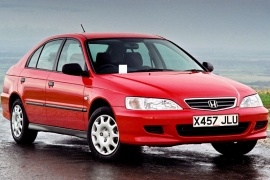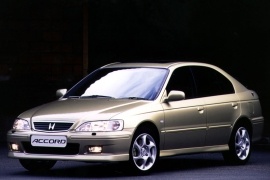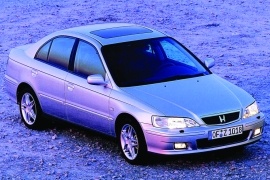HONDA Accord Euro Models/Series Timeline, Specifications & Photos
First production year: 1998
Engines: Gasoline, Diesel
Right before the world economic crisis broke in, Honda unveiled its ninth generation of the mid-size sedan Accord for Europe at the 2008 Geneva Motor Show.
The Accord was already known in Europe for its reliability and sportiness sedan capability. Even though it was offered with only three engine choices and an outdated automatic gearbox, its sales were decent. The previous generation, the Accord 8, was highly criticized for its stiff suspension that affected the comfort. The ninth-generation fixed that along with some other issues.
From the outside, the 2008 Accord was bigger than its predecessor. There were more rounded edges and flared fenders and rear quarter panels. It kept the aggressive styling but not that aggressive as the eighth generation. The ninth generation of the Accord fitted innovative safety systems such as the CMBS (Collision Mitigation Braking System) and LKAS (Lane Keep Assist System), which made the car steer and brake autonomously. Later on, the CMBS system became mandatory for commercial vehicles and extensively used on regular ones. It used a camera and a laser beam to measure the distance to the front obstacle and the speed difference. It warned the driver and braked the car.
Inside, there was a new interior, with a new infotainment unit. It wasn't touch-sensitive, but it was controlled via a rotary knob on the center console. There was enough room for five adults.
For the engine compartment, Honda offered two naturally aspirated gasoline units and a turbodiesel. The standard gearbox for all the range was a 6-speed manual, while a 5-speed automatic with paddle shifters was available as an option.
Just over three years after introducing the seventh generation of the Accord, Honda launched a refreshed version at the 2005 Frankfurt Motor Show.
Honda showed some signs of slowing its pace in the mid-size sedan segment. Unlike some of the previous generations of the Accord, which were kept on the market for just three or four years, the car manufacturer took a different approach this time. Instead of completely changing the car, it improved it significantly in all areas. However, some of the exterior upgrades were hardly noticeable, and the same went with the car’s interior. For the engineering department, on the other hand, the automaker made a few more substantial changes, especially in the safety department.
Even though the car still looked fresh, Honda knew it could do better. As a result, the car’s front fascia was updated with new headlights that kept the same shape, although their interior was changed. In addition, the upper grille was redesigned, sporting a wider area, and it was adorned with two chromed V-shaped slats that supported the center-mounted H-badge. Due to the redesigned main grille, the automaker had to slightly alter the bumper's shape, which still featured a trapezoidal-shaped air intake but with clear cuts. It was flanked by available oval-shaped fog lamps and a pair of scoops that brought fresh air to the front brakes.
From its profile, the most noticeable difference was the wheels’ look, which featured a nine-spoke design. In addition, the automaker added new side sills with a more profound aerodynamic shape than their predecessors. Out back, Honda placed a new set of taillights, which followed the same position and shape, albeit with two clear inner lenses for the reversing lights. Like its predecessor, the rear bumper had one or two cuts, depending on the engine.
Inside, there were other small changes that made customers feel happy with the car. The dashboard featured the same layout with a large speedometer in the middle and an LCD at its bottom, flanked by the tachometer on the left and by the fuel and coolant temperature gauges on the right. Furthermore, the center stack was slightly redesigned and had a sound system with an in-dash CD changer for six discs. The bolstered seats covered with velour were standard across the range, while the most expensive version, the Executive, could be ordered with leather upholstery. In addition, the automaker offered the option for a sunroof and a sat-nav unit.
Under the hood, there were some changes that affected the car’s behavior. The two-liter engine was fitted with a drive-by-wire (DBW) system, which helped the electronics keep the car on the road even better. In addition, Honda offered the car the award-winning LKAS (lane keep assist system), fitted with a forward radar. Furthermore, the refreshed version of the Accord was also available with dynamic cruise control. The suspension was also recalibrated so the car could be felt more like a sports sedan than a regular family vehicle.
Honda introduced the seventh generation of the Accord in late 2002 for the 2003 model year in Japan, Europe, Australia, and New Zealand, surprising its customers with its sharp design.
After more than a decade of creating rounded-shaped vehicles, the Japanese automaker decided to start the design of the Accord’s seventh generation from a blank sheet of paper. Kunihiko Tachibana and Hiroshi Ishibani penned the vehicle in 2000, and the car was ready for launch two years later. The car didn’t inherit anything from its predecessor and was entirely new from tip to toe. Unlike the sixth generation of this nameplate, which carried over some of the F and H family of engines, the 2003 Honda Accord came with the K-family of powerplants for the gasoline versions, while the 2.2-liter turbodiesel was also new. It was the first oil-burner engine made by Honda for automotive applications, and it won the 2005 Engine of the Year Award in its category.
Design-wise, the seventh generation of the European Accord came with an angular, aggressive styling. Its pentagonal-shaped grille pointed downwards where the badge took center stage. The headlights followed the same design language with clear lenses and distinct headlamps that also integrated the turn signal lamps. On the lower side of the bumper, in the apron, the automaker placed a second air intake that helped to cool the engine, flanked by a pair of scoops for the available oval-shaped fog lamps.
From its profile, the ascending waistline of the vehicle was adorned on the door panels with chromed trims. The raked windshield and curved roof formed a spacious greenhouse, while at the back, the car ended into a short and horizontal deck, slightly curved on its outer sides. Finally, at the back, the 2003 Honda Accord featured angular-shaped taillights that sported a distinct design with round lamps. Below the bumper, the automaker installed different exhausts, depending on the engine version, with one or two exhausts.
Inside, customers found a tall dashboard with a rounded-shaped instrument cluster fronting the driver, where the speedometer took center stage and was the largest dial. It was flanked on its left by the tachometer, while on the right were the gauges for the fuel level and coolant temperature, similar to the pattern seen on the 1993 Accord. Unlike that model, the 2003 model year came with buttons on the steering wheel and a taller center stack. There, depending on the options, Honda installed a CD Stereo for the lower grades, while the upper ones were fitted with sat-nav. The automatic transmission and the sunroof were available as options across the range, depending on the country.
Under the hood, Honda installed a choice of two gasoline and one turbodiesel engine. The former two had 2.0 and 2.4-liter displacements, respectively, while the oil burner was a 2.2-liter unit. All engines had met the Euro 4 emission standards but were ready to be quickly adapted for the Euro 5 norms that followed after 2005. The four-wheel independent suspension remained one of the most significant advantages of the Accord.
Just three years after the introduction of the sixth generation of the Accord, the Japanese automaker refreshed it, and the updates affected both the sedan and the hatchback version.
The Accord was already an established nameplate on the market. Customers knew it and appreciated its reliability and rich standard features. At the same time, the design was not the strongest selling point for the vehicle. However, for the sixth generation of the Accord, the Japanese automaker found the Europeans’ hot spot and penned this mid-size sedan accordingly. But then, just a few years after the model’s launch, Honda facelifted it to keep its image fresh on a market craving for something new. As a result, in 2001, the car manufacturer restyled the Accord and continued selling it until late 2002, when its successor was launched. Furthermore,
At first glance, there were no visible changes on the 2001 Honda Accord Hatchback compared to its non-facelifted sibling. However, a keen eye for detail could notice the clear lenses for the headlights. Between them, the automaker placed a new grille with a pentagonal shape, sharper edges, and a chromed surrounding. Furthermore, the bumper received a new apron that sported a broader air intake in the middle flanked by a pair of aerodynamically profiled side scoops that could house the fog lamps.
From its profile, the rakish look of the 2001 Honda Accord Hatchback was identical to its Sedan sibling up to the B-posts. Furthermore, the rear doors were the same for both bodywork versions. However, the C-post was different. It was wider in its lower area than the one from the four-door version. Surprisingly, Honda didn’t consider installing body-colored flush door handles, a design trend already gaining some supporters. At the back, the automaker added a window wiper to help the driver get a better view behind them. The taillights, on the other hand, were carried over from the non-facelifted version. One of the tiny details that differentiated the refreshed versus the non-refreshed model was the aerial antenna. The 1999 model year had it installed on the rear quarter panel and powered, while the 2001 model year came with it attached at the back of the roof, above the tailgate.
Inside, the automaker made some minor changes after it discussed with its customers. Since some of them complained about having the controls for the stereo mounted below the HVAC control panel, Honda swapped their positions so the volume knob was more accessible to reach. Furthermore, those who had the option for the automatic climate control installed didn’t use the dials for ventilation too much. Honda also offered an option for a sat-nav system instead of the standard tape player and even a Bose audio. There were no changes to the velour upholstery or seats, which were still manually adjustable and not powered. At the back, the split-folding bench seat expanded the trunk space.
Under the hood, things remained the same, depending on the country. While in the UK, the car was available with either a 1.8- or a 2.0-liter gasoline engine, the rest of Europe also had it with a 1.6-liter powerplant and a turbodiesel. The five-speed manual transmission was standard across the range, while a four-speed automatic was available for selected engines.
Honda introduced the sixth generation of the Accord for the European market in 1998 as a sedan, followed by a hatchback with five doors in the following year.
The Japanese automaker replaced the fifth generation of the Accord after just six years, and surprisingly, instead of making the car longer, it shrunk it. Furthermore, it sold it in two bodywork versions: as a sedan and as a five-door hatchback. While the former was something customers could see coming, the latter was more of a surprise. Honda tried to provide them with a spacious vehicle that could combine the advantages of a station wagon with the look of a sedan. Unfortunately, the car didn’t excel in either of these segments. Instead, it proved to the automaker that the era of mid-size hatchbacks was almost gone, leaving this niche segment to other European car manufacturers such as Ford, Opel, or Renault.
At the front, the 1999 Honda Accord 5-door shared its fascia with its sedan sibling. It featured sporting wide headlights narrowed on their inner side and wrapped around corners. Its chrome-surrounded grille was integrated into the front side of the hood, which sported the carmaker’s badge. Lower, on the plastic bumper, the automaker added a second air intake that helped cool the engine, and a set of rectangular fog lamps were available.
Up to the B-pillars, the 1999 Honda Accord hatchback shared its body panels with the sedan, featuring a raked windshield and a short front overhang. Its roof was just a bit longer than its four-door brother, while the C-posts were significantly wider, especially on the lower side. As a result, the rear window was tilted forward even more, and the deck was shorter. In addition, this version of the Accord was available with a rear windshield wiper as an option. Its corner-mounted taillights flanked the tailgate’s opening. Honda tried to use as many common components for both vehicles as possible without creating the impression that it made a compromise.
Inside, customers found a dashboard that featured an instrument panel with three round clusters. In the middle, Honda installed the speedometer, flanked on the left by the tachometer and on the right by the gauges for the fuel level and the water temperature. The automaker installed comfortable bucket seats at the front with mild side bolstering. Between them, the center console housed an armrest and the gear stick, while Honda placed the stereo and the HVAC control panel on the center stack. In the back, legroom was limited due to the shorter legroom than in the previous generation. However, the split-folding (60/40) bench seat proved to be comfortable for two adults.
Under the hood, the automaker installed a wide range of gasoline engines and a turbodiesel. The former ones were those most sought-after from the range. At the same time, the oil-burner proved to be effective, especially for those looking to save money. A five-speed manual was fitted as standard across the range, while a four-speed automatic was on the offer at extra cost.
Honda introduced the sixth generation of the European version of the Accord in 1998, and the Japanese automaker produced the car in England at the Swindon factory.
Honda realized that it had made a mistake when it enlarged the fifth generation of the Accord and reduced the car’s size for the sixth generation of this nameplate, proving that sometimes smaller means better. The car was available as a four-door sedan, a five-door hatchback, and a coupe. Customers could get the vehicle in a few grades and with enough choices of engines and transmissions to make it appealing.
The four-door sedan version shared its front fascia with its five-door sibling, sporting wide headlights narrowed on their inner side and wrapped around corners. Its chrome-surrounded grille was integrated into the front side of the hood and sported the carmaker’s badge. Lower, on the plastic bumper, the automaker added a second air intake that helped cool the engine, and a set of rectangular fog lamps were available.
The sixth generation of the Accord came with a sporty look, emphasized by the ascending beltline and the darkened B-posts. Honda emphasized that with a cab-rearward design for the greenhouse, a short and tall rear deck, and standard alloy wheels, depending on the grade. The top-of-the-range Accord Type R even had a rear deck spoiler and a unique design for the wheels.
Honda created the Accord with an ascending beltline and a cab rearward look of the greenhouse that started with a raked, panoramic windshield. The automaker added darkened B-posts to the recipe to make the car look sportier. Furthermore, it placed body-colored door mirror caps and flush door handles. At the back, the short and tall deck could’ve been optioned with a rear wing, depending on the grade. The rear fascia revealed the corner-mounted taillights that flanked the narrow opening of the trunk’s lid. A plastic bumper wrapped around the car’s rear end completed the image of this sporty compact sedan built for the European market.
Customers were welcomed inside by a well-designed and spacious cabin that provided enough room for four adults or five for short jaunts. In front of the driver, Honda placed its clean-layout instrument cluster filled with four dials and gauges and an LED display for the odometer. On the center stack, the automaker placed the controls for the HVAC unit and the radio tape player with an option for a Bose sound system. Furthermore, a Honda Navigation system was also available for specific countries. A split-folding rear bench seat with standard velour upholstery complemented the front bucket seats. Customers with deeper pockets could get the car with a leather-wrapped interior and heated front seats.
Under the hood, Honda installed a limited choice of engines under the Accord sixth’s hood. The base version was a 1.6-liter inline-four, but only for specific European countries. At the other end of the scale stood the mighty H22A7 powerplant that was made to be raced.
